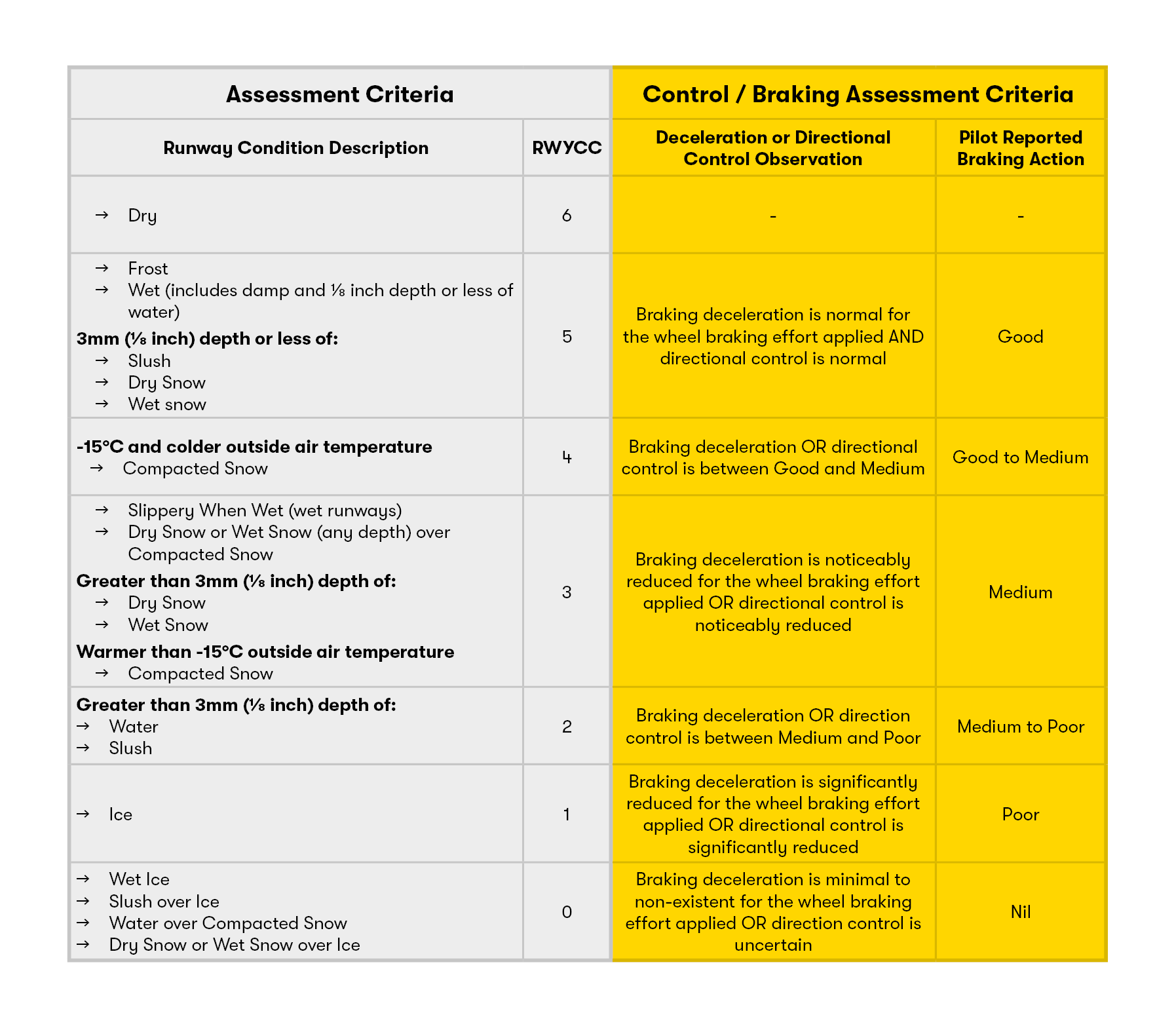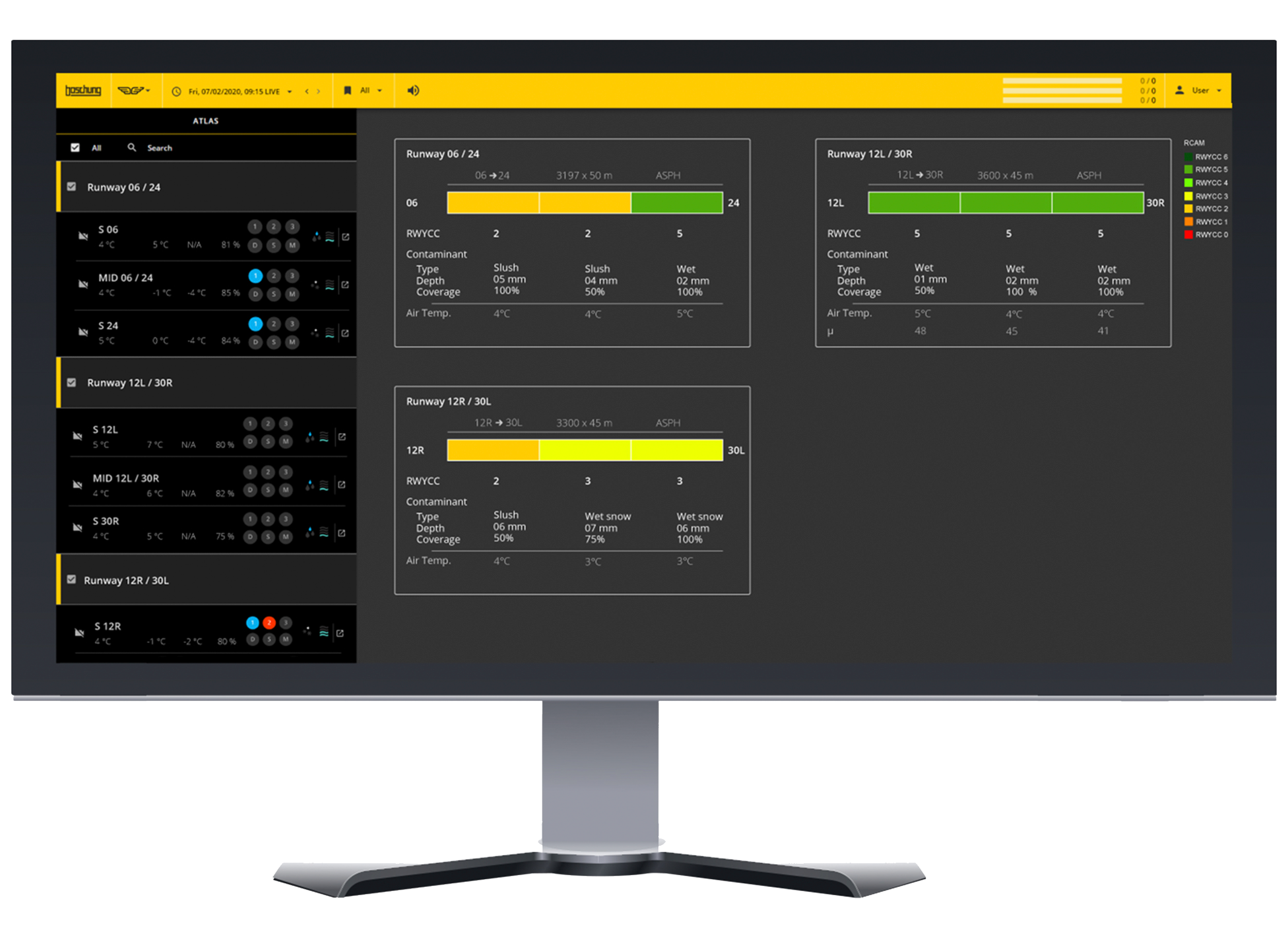La revolución del barrido. La Urban-Sweeper S2.0 MAX ya está disponible. Descubra más
Volver
Caso práctico
Hacia la automatización de la notificación de las condiciones de las pistas
La OACI (Organización de Aviación Civil Internacional) ha fijado el 5 de noviembre de 2020 como fecha límite para la aplicabilidad del Formato Global de Notificación (GRF), la nueva metodología para evaluar y notificar las condiciones de la superficie de las pistas, con la intención de convertirlo en el único formato de notificación «armonizado a nivel mundial» para la aviación internacional. El GRF se compone de los siguientes elementos, proporcionados para cada tercio de pista:
- código del estado de la pista (RWYCC), realizado como un simple número entre 0 y 6 para reflejar la capacidad de frenado de la pista en función del estado de la superficie
- tipo de contaminante, extraído de una lista de los denominados descriptores
- profundidad del contaminante
- cobertura del contaminante

A continuación, la información del GRF se utiliza para completar un informe estándar denominado Informe sobre el estado de la pista (RCR). El RCR es la información que se transmite a los pilotos para que puedan planificar los procesos de aterrizaje en función del rendimiento de frenado estimado de la aeronave.
Obsolescencia de las pruebas de fricción
Una de las razones de la introducción del GRF es la necesidad de una armonización global, ya que las metodologías actuales no podían aceptarse a nivel mundial. A modo de ejemplo, el uso de vehículos de pruebas de fricción (los llamados Mu-metros) ha sido constantemente cuestionado. Desde un punto de vista práctico, la validez de los valores de fricción no podía confirmarse debido a la falta de reproducibilidad y fiabilidad de la calibración del sistema. En consecuencia, no se ha podido demostrar una correlación teórica entre las mediciones de la fricción realizadas por los Mu-metros y el rendimiento de las aeronaves. El uso de vehículos de ensayo de la fricción en las pistas sigue estando permitido, pero en lo que respecta a la GRF, la medición de la fricción no puede ser el único criterio para el RWYCC, como se establece en el «Aeródromos - Anexo 14» de la OACI.
La solución ATLAS
Main challenges related to the GRF are the number of different contaminant types and the measurements of their depth. For example, from discussions of meetings organized by the EUROCAE, it is indeed a very complex task to differentiate the different types of snow.
Therefore, existing sensors on the market cannot solve the issues related to the GRF. A response to the applicability of the GRF is the ATLAS solution developed by Boschung, which includes the development of new sensors and methods.
ATLAS stands for “Automated Take-off and Landing Assessment System” and is a solution that automatically provides the elements required by the GRF. The RWYCC, the type, depth and coverage of contaminant are issued under any circumstances without the need for further external components.
The system bases on the technologies developed by Boschung for the last 40 years in the field of ice early warning systems with powerful pavement and atmospheric sensors. It includes innovations such as the IT-RWY, a new pavement sensor that can measure runway conditions and contaminant depth, and the r-snow, a snow measurement device that provides snow depth and types with an unbeatable accuracy. The system detects the surrounding weather conditions and is as effective in winter as it is in summer!
Depending on different characteristics of the airport (airport size, runway length, snowfall frequency), the ATLAS solution is adapted in a modular and scalable way. That is, the ATLAS can be adopted by airports even with existing third-party AWOS or ice warning systems.
Visualization of the results are done on BORRMA (Boschung Road and Runway Management) software. BORRMA integrates therefore a new layer for runways that will complement the existing modules used on airports for weather information systems including forecasting information and operating vehicle interventions.

“With ATLAS, we made a very strong achievement in the field of detection systems for the international aviation. We are confident that our modular system can support operations of all kinds of airports, in all regions of the world with any climate, and with any pre-existing system” says Filipe Lourenço, CEO of Boschung Mecatronic in Switzerland. “As a part of the combination of all the Boschung systems for runway operations – from ice early warning systems to multi-functional vehicles – ATLAS contributes to our commitment for a durable, economic and ecological impact for worldwide airports.”
System automation and the role of runway inspectors
The output of the GRF-required data is done in an automated way by the ATLAS solution. The need for human inspections is very limited. The idea is not to completely replace runway inspectors with a detection system, but to greatly facilitate their work.
On the one hand, if runway conditions are good (in GRF terms: if the output is 6/dry/0/NR) or if the conditions are very clear on all runway thirds, inspecting the runway gets an unnecessary tasks. In cases where the conditions on the runway thirds are disparate, this provides to the inspectors an indication about zones need to be controlled with priority. Actually, this also means that the conditions are in changing states (snow melting into slush and water) and it is even more important to catch these changes in an automated way since the inspectors cannot be all the time next to the runway.
On the other hand, human inspections are confirmed by our fully autonomous system. Having live as well as historical data of the runway conditions is a confirmation of the inspectors’ work. This is a method to support the values issued by the inspectors.
Closing runways will always have a cost
The ATLAS solution is available 24/7. RWYCC are given for any weather. Only specific sensors will stop measuring if there is no need to do so: indeed, the active pavement sensors will not measure any freezing point if temperature is above 4°C, saving at the same time energy of the system.
Sensors are positioned in accordance to the specific locations on the runways so that they can provide the most reliable and representative data of those runways. The scalability of the system offers also the possibility to increase the number of measuring points on the runways without the need for supplementary measuring stations.
Therefore, having an optimal coverage of the runways with an autonomous system like ATLAS eliminates the need for closing the runways. This has also been a critical issue related to friction testing made by vehicles, with evident negative impacts on air traffic. To avoid the disadvantages of closing runways and of measuring with more or less reliability friction parameters, ATLAS expressively declines the use of complementary mobile sensors or friction measurement devices as a means to apply the GRF.
However, if friction values are of interest of the airport operation staff, the solution to get such information will come from data provided by those sensors that are constantly on the runway, namely the aircrafts themselves…